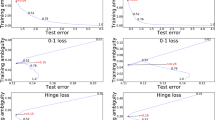Abstract
In this paper we propose a general framework for analysing the diversity of ensembles of word sequence recognition systems. The goal of the framework is to enable the application of any diversity measure developed for standard multi-class classification problems to ensembles of word sequence recognisers. Experiments with several diversity measures are conducted on artificial as well as on real world data and show the effectiveness of the proposed approach.
Chapter PDF
Similar content being viewed by others
Keywords
These keywords were added by machine and not by the authors. This process is experimental and the keywords may be updated as the learning algorithm improves.
References
Oza, N.C., Polikar, R., Kittler, J., Roli, F. (eds.): MCS 2005. LNCS, vol. 3541. Springer, Heidelberg (2005)
Huang, T., Suen, C.: Combination of multiple experts for the recognition of unconstrained handwritten numerals. IEEE Transactions on Pattern Analysis and Machine Intelligence 17, 90–94 (1995)
Gader, P., Mohamed, M., Keller, J.: Fusion of handwritten word classifiers. Pattern Recognition Letters 17, 577–584 (1996)
Günter, S., Bunke, H.: Ensembles of classifiers for handwritten word recognition. International Journal on Document Analysis and Recognition 5, 224–232 (2003)
Nakano, Y., Hananoi, T., Miyao, H., Maruyama, M., Maruyama, K.: A document analysis system based on text line matching of multiple OCR outputs. In: Marinai, S., Dengel, A.R. (eds.) DAS 2004. LNCS, vol. 3163, pp. 463–471. Springer, Heidelberg (2004)
Wilczok, E., Lellmann, W.: Adaptive combination of commercial OCR systems. In: Dengel, A.R., Junker, M., Weisbecker, A. (eds.) Reading and Learning. LNCS, vol. 2956, pp. 124–136. Springer, Heidelberg (2004)
Bertolami, R., Bunke, H.: Multiple handwritten text recognition systems derived from specific integration of a language model. In: 8th International Conference on Document Analysis and Recognition, Seoul, Korea, vol. 1, pp. 521–524 (2005)
Windeatt, T.: Diversity measures for multiple classifier system analysis and design. Information Fusion 6, 21–36 (2004)
Brown, G., Wyatt, J., Harris, R., Yao, X.: Diversity creation methods: A survey and categorisation. Information Fusion 6, 5–20 (2005)
Kuncheva, L.I.: Combining Pattern Classifiers: Methods and Algorithms. John Wiley & Sons Inc., Chichester (2004)
Fiscus, J.: A post-processing system to yield reduced word error rates: Recognizer output voting error reduction. In: IEEE Workshop on Automatic Speech Recognition and Understanding (ASRU), Santa Barbara, pp. 347–352 (1997)
Wang, L., Jiang, T.: On the complexity of multiple sequence alignment. Journal of Computational Biology 1, 337–348 (1994)
Sharkey, A., Sharkey, N.: Combining diverse neural networks. The Knowledge Engineering Review 12, 231–247 (1997)
Bertolami, R., Bunke, H.: Ensemble methods for handwritten text line recognition systems. In: International Conference on Systems, Man and Cybernetics, Hawaii, USA, pp. 2334–2339 (2005)
Marti, U.V., Bunke, H.: The IAM-database: an English sentence database for offline handwriting recognition. International Journal on Document Analysis and Recognition 5, 39–46 (2002)
Author information
Authors and Affiliations
Editor information
Editors and Affiliations
Rights and permissions
Copyright information
© 2006 Springer-Verlag Berlin Heidelberg
About this paper
Cite this paper
Bertolami, R., Bunke, H. (2006). Diversity Analysis for Ensembles of Word Sequence Recognisers. In: Yeung, DY., Kwok, J.T., Fred, A., Roli, F., de Ridder, D. (eds) Structural, Syntactic, and Statistical Pattern Recognition. SSPR /SPR 2006. Lecture Notes in Computer Science, vol 4109. Springer, Berlin, Heidelberg. https://doi.org/10.1007/11815921_74
Download citation
DOI: https://doi.org/10.1007/11815921_74
Publisher Name: Springer, Berlin, Heidelberg
Print ISBN: 978-3-540-37236-3
Online ISBN: 978-3-540-37241-7
eBook Packages: Computer ScienceComputer Science (R0)





